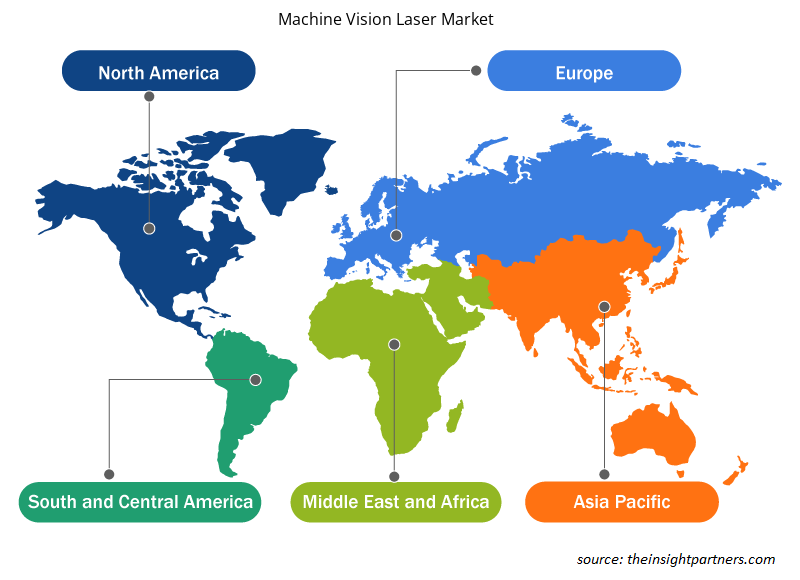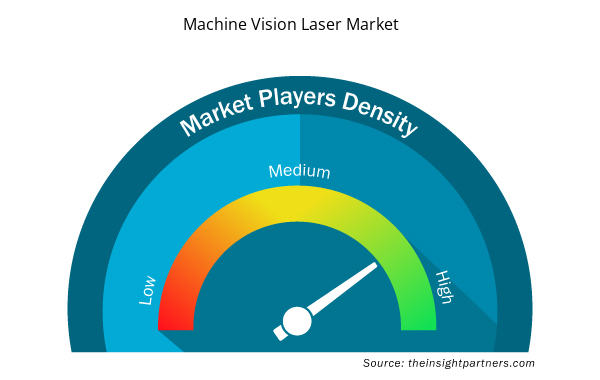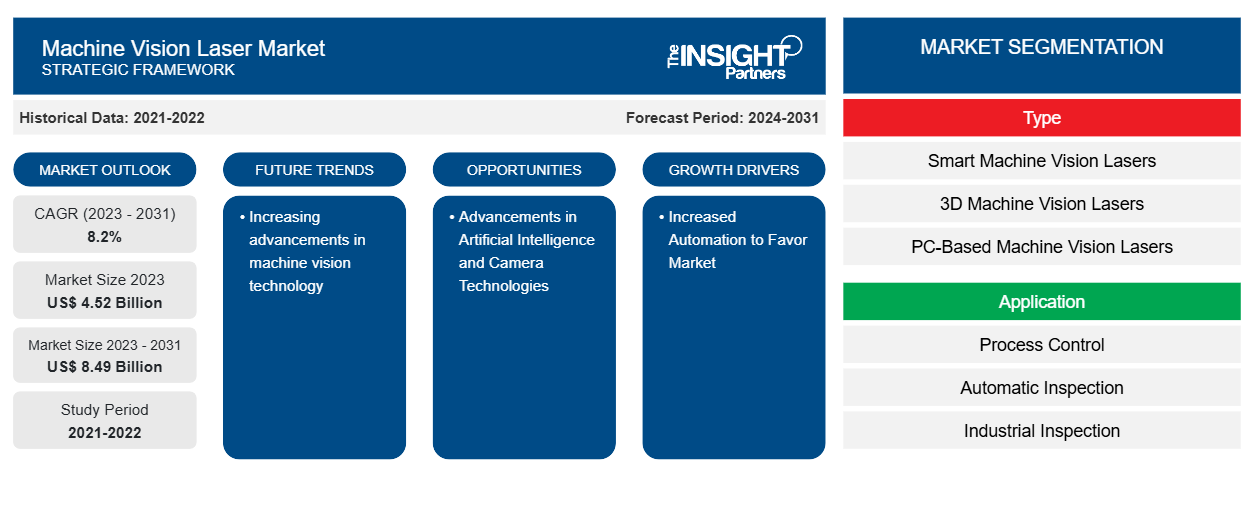Der globale Markt für Bildverarbeitungslaser soll von 4,52 Milliarden US-Dollar im Jahr 2023 auf 8,49 Milliarden US-Dollar im Jahr 2031 wachsen; von 2024 bis 2031 wird eine durchschnittliche jährliche Wachstumsrate von 8,2 % erwartet. Die zunehmenden Fortschritte in der Bildverarbeitungstechnologie werden voraussichtlich ein wichtiger Markttrend für Bildverarbeitungslaser bleiben.CAGR of 8.2% from 2024 to 2031. The increasing advancements in machine vision technology are likely to remain a key machine vision laser market trends.
Marktanalyse für Laser zur maschinellen Bildverarbeitung
Der steigende Bedarf an verbesserter Qualitätsprüfung und Automatisierung in verschiedenen Branchen dürfte das Marktwachstum ankurbeln.
Marktübersicht für Laser zur industriellen Bildverarbeitung
Lasersysteme für maschinelles Sehen (MV) verwenden Videokameras, digitale Signalverarbeitung und Analog-Digital-Umwandlung, damit Computer die Arbeitsleistung betrachten, untersuchen und bewerten können. Diese Systeme sammeln Daten, die anschließend zur Verarbeitung und Erstellung der erforderlichen Ausgabe an einen Computer gesendet werden . Auflösung und Empfindlichkeit sind zwei kritische Parameter in MV-Systemen. Die Auflösung bestimmt die Fähigkeit des Systems, zwischen Dingen zu unterscheiden. Gleichzeitig bezieht sich die Empfindlichkeit auf die Fähigkeit der Maschine, Objekte oder schwache Signale bei schlechten Lichtverhältnissen oder bei Wellenlängen zu identifizieren, die für das menschliche Auge unsichtbar sind. Diese Systeme sind für die Verwaltung von Arbeitsumgebungen von entscheidender Bedeutung, einschließlich Funktionen wie Prozesssteuerung, Roboterführung und automatisierte Inspektion in industriellen Anwendungen.MV) laser systems use video cameras, digital signal processing, and analog-to-digital conversion to let computers to view, examine, and assess job performance. These systems collect data, which is subsequently sent to a MV systems. Resolution determines the system's capacity to distinguish between things. At the same time, sensitivity refers to the machine's capacity to identify objects or weak signals in low-light settings or at wavelengths that are invisible to the human eye. These systems are critical in managing work environments, including functions such as process control, robotic guiding, and automated inspection in industrial applications.
Passen Sie diesen Bericht Ihren Anforderungen an
Sie erhalten kostenlos individuelle Anpassungen an jedem Bericht, einschließlich Teilen dieses Berichts oder einer Analyse auf Länderebene, eines Excel-Datenpakets sowie tolle Angebote und Rabatte für Start-ups und Universitäten.
- Holen Sie sich die wichtigsten Markttrends aus diesem Bericht.Dieses KOSTENLOSE Beispiel umfasst eine Datenanalyse von Markttrends bis hin zu Schätzungen und Prognosen.
Treiber und Chancen auf dem Markt für Laser zur industriellen Bildverarbeitung
Erhöhte Automatisierung kommt dem Markt zugute
Die Automatisierung erfreut sich in vielen Branchen zunehmender Beliebtheit, angetrieben durch den Wunsch nach mehr Effizienz und Qualitätskontrolle. Dieser Trend ist besonders in der Fertigung und Logistik zu beobachten. Der Einsatz von Automatisierungsprozessen hat zu einem erhöhten Bedarf an Bildverarbeitungssystemen, insbesondere laserbasierten Technologien, geführt, um diese automatisierten Abläufe zu verbessern. Der Einsatz von Automatisierung in Produktion und Logistik bietet mehrere Vorteile. Ein wichtiger Vorteil ist die bessere Kontrolle und Einheitlichkeit der Produktqualität. Automatisierte Systeme führen Produktionsabläufe oft mit geringerer Variabilität durch als menschliche Arbeiter und ermöglichen so eine bessere Kontrolle der Produktqualität.
Fortschritte in der künstlichen Intelligenz und Kameratechnologien
Fortschritte in der künstlichen Intelligenz (KI) und der Kameratechnologie haben das Wachstum und die Entwicklung des Marktes für maschinelles Sehen erheblich gefördert. Diese Verbesserungen haben die Fähigkeiten von Systemen für maschinelles Sehen verbessert und sie in einer Vielzahl von Anwendungen präziser und effizienter gemacht. Einer der bedeutendsten Fortschritte in der maschinellen Bildverarbeitung ist der zunehmende Einsatz von KI und Deep-Learning-Ansätzen. Algorithmen und Deep-Learning-Ansätze ermöglichen es Computern, aus Daten zu lernen und ihre Leistung selbstständig zu verbessern, ohne dass menschliches Eingreifen erforderlich ist. Dies hat zur Entwicklung immer komplexerer Systeme für maschinelles Sehen geführt, die Bilder oder Filme mit höherer Genauigkeit und Geschwindigkeit erkennen und analysieren können.
Segmentierungsanalyse des Marktberichts für maschinelles Sehen von Lasern
Schlüsselsegmente, die zur Ableitung der Marktanalyse für maschinelles Sehen mit Lasern hinsichtlich Typ, Anwendung und Endbenutzer beigetragen haben.
- Nach Typ ist der Markt in intelligente Bildverarbeitungslaser, 3D-Bildverarbeitungslaser und PC-basierte Bildverarbeitungslaser unterteilt. Das Segment der intelligenten Bildverarbeitungslaser hatte im Jahr 2023 einen größeren Marktanteil.
- Basierend auf der Anwendung ist der Markt in Prozesssteuerung, automatische Inspektion, industrielle Inspektion und andere unterteilt. Das Segment der automatischen Inspektionslaser hatte im Jahr 2023 einen größeren Marktanteil.
- Basierend auf dem Endverbraucher ist der Markt in die Bereiche Automobil, Elektronik und Halbleiter, Lebensmittel und Getränke, Pharmazeutika, Logistik und andere unterteilt. Das Automobilsegment hatte im Jahr 2023 einen größeren Marktanteil.
Marktanteilsanalyse für Machine Vision Laser nach geografischer Lage
Der geografische Umfang des Marktberichts für maschinelles Sehen mit Lasern ist hauptsächlich in fünf Regionen unterteilt: Nordamerika, Asien-Pazifik, Europa, Naher Osten und Afrika sowie Südamerika/Süd- und Mittelamerika. Nordamerika dominierte den Markt für maschinelles Sehen mit Lasern im Jahr 2023. Die steigende Nachfrage nach Automatisierung und die Integration fortschrittlicher Bildgebungstechnologien in einer Vielzahl von Branchen treiben den Markt für maschinelles Sehen mit Lasern in Nordamerika an. Darüber hinaus wird erwartet, dass der Fokus auf technologische Fortschritte durch wichtige Akteure auf dem Markt das Wachstum des Marktes für maschinelles Sehen mit Lasern vorantreiben wird. Zu diesen Fortschritten gehören die Entwicklung plattformunabhängiger Software, intelligenter Kameras, 3D-Sensoren und Bildverarbeitungssteuerungen.
Regionale Einblicke in den Markt für Laser zur maschinellen Bildverarbeitung
Die regionalen Trends und Faktoren, die den Markt für maschinelles Sehen mit Lasern während des Prognosezeitraums beeinflussen, wurden von den Analysten von Insight Partners ausführlich erläutert. In diesem Abschnitt werden auch die Marktsegmente und die Geografie für maschinelles Sehen mit Lasern in Nordamerika, Europa, im asiatisch-pazifischen Raum, im Nahen Osten und Afrika sowie in Süd- und Mittelamerika erörtert.

- Erhalten Sie regionale Daten zum Markt für Laser-Maschinensichtgeräte
Umfang des Marktberichts über Laser zur maschinellen Bildverarbeitung
| Berichtsattribut | Details |
|---|---|
| Marktgröße im Jahr 2023 | 4,52 Milliarden US-Dollar |
| Marktgröße bis 2031 | 8,49 Milliarden US-Dollar |
| Globale CAGR (2023 - 2031) | 8,2 % |
| Historische Daten | 2021-2022 |
| Prognosezeitraum | 2024–2031 |
| Abgedeckte Segmente | Nach Typ
|
| Abgedeckte Regionen und Länder | Nordamerika
|
| Marktführer und wichtige Unternehmensprofile |
|
Marktteilnehmerdichte: Der Einfluss auf die Geschäftsdynamik
Der Markt für Machine Vision Laser wächst rasant, angetrieben durch die steigende Nachfrage der Endnutzer aufgrund von Faktoren wie sich entwickelnden Verbraucherpräferenzen, technologischen Fortschritten und einem größeren Bewusstsein für die Vorteile des Produkts. Mit steigender Nachfrage erweitern Unternehmen ihr Angebot, entwickeln Innovationen, um die Bedürfnisse der Verbraucher zu erfüllen, und nutzen neue Trends, was das Marktwachstum weiter ankurbelt.
Die Marktteilnehmerdichte bezieht sich auf die Verteilung der Firmen oder Unternehmen, die in einem bestimmten Markt oder einer bestimmten Branche tätig sind. Sie gibt an, wie viele Wettbewerber (Marktteilnehmer) in einem bestimmten Marktraum im Verhältnis zu seiner Größe oder seinem gesamten Marktwert präsent sind.
Die wichtigsten auf dem Markt für Laser zur industriellen Bildverarbeitung tätigen Unternehmen sind:
- Cavitar Ltd.
- Cognex Corporation
- Laser Components GmbH
- Laserex
- Keyence Corporation
- ProPhotonix
Haftungsausschluss : Die oben aufgeführten Unternehmen sind nicht in einer bestimmten Reihenfolge aufgeführt.

- Überblick über die wichtigsten Akteure auf dem Markt für maschinelles Sehen mit Lasern
Neuigkeiten und aktuelle Entwicklungen zum Markt für maschinelles Sehen mit Lasern
Der Markt für maschinelles Sehen mit Lasern wird durch die Erhebung qualitativer und quantitativer Daten nach Primär- und Sekundärforschung bewertet, die wichtige Unternehmensveröffentlichungen, Verbandsdaten und Datenbanken umfasst. Im Folgenden finden Sie eine Liste der Entwicklungen auf dem Markt:
- Im Oktober 2023 stellte Keyence Corporation die VS-Serie vor, eine neue Reihe intelligenter Kamera-Vision-Systeme. Dieses System ist benutzerfreundlich konzipiert und erfordert weder ein Bedienfeld noch Software zur Überprüfung von IP-Adressen und Verbindungen. Es ist nach IP67 zertifiziert und verfügt über mehrere Funktionen, die seine Funktionalität verbessern. Zu diesen Funktionen gehören ein integrierter Laserpointer, vier Montagelöcher für flexible Installationskonfigurationen und Unterstützung für Power over Ethernet, wodurch sowohl die Kamera als auch das Licht über ein einziges Ethernet-Kabel mit Strom versorgt werden können.
(Quelle: Keyence Corporation, Pressemitteilung, 2023)
Marktbericht zu Lasern für maschinelles Sehen – Umfang und Ergebnisse
Der Bericht „Marktgröße und Prognose für maschinelles Sehen mit Lasern (2021–2031)“ bietet eine detaillierte Analyse des Marktes, die die folgenden Bereiche abdeckt:
- Marktgröße und Prognose auf globaler, regionaler und Länderebene für alle wichtigen Marktsegmente, die im Rahmen des Projekts abgedeckt sind
- Marktdynamik wie Treiber, Beschränkungen und wichtige Chancen
- Wichtige Zukunftstrends
- Detaillierte PEST/Porters Five Forces- und SWOT-Analyse
- Globale und regionale Marktanalyse mit wichtigen Markttrends, wichtigen Akteuren, Vorschriften und aktuellen Marktentwicklungen
- Branchenlandschaft und Wettbewerbsanalyse, einschließlich Marktkonzentration, Heatmap-Analyse, prominenten Akteuren und aktuellen Entwicklungen
- Detaillierte Firmenprofile
- Historische Analyse (2 Jahre), Basisjahr, Prognose (7 Jahre) mit CAGR
- PEST- und SWOT-Analyse
- Marktgröße Wert/Volumen – Global, Regional, Land
- Branche und Wettbewerbsumfeld
- Excel-Datensatz


- Artwork Management Software Market
- Fertilizer Additives Market
- Fill Finish Manufacturing Market
- Europe Industrial Chillers Market
- Airport Runway FOD Detection Systems Market
- Public Key Infrastructure Market
- Vaginal Specula Market
- Customer Care BPO Market
- Integrated Platform Management System Market
- Legal Case Management Software Market

Report Coverage
Revenue forecast, Company Analysis, Industry landscape, Growth factors, and Trends

Segment Covered
This text is related
to segments covered.

Regional Scope
North America, Europe, Asia Pacific, Middle East & Africa, South & Central America

Country Scope
This text is related
to country scope.
Häufig gestellte Fragen
The machine vision laser market size is expected to grow from US$ 4.52 billion in 2023 to US$ 8.49 billion by 2031; it is anticipated to expand at a CAGR of 8.2% from 2024 to 2031.
The global machine vision laser market is expected to reach US$ 8.49 billion by 2031.
The increasing advancements in machine vision technology are likely to remain a key machine vision laser market trend.
The key players holding the majority of shares in the global machine vision laser are Keyence Corporation, ProPhotonix, RAYLASE GMBH, RPMC Lasers, and STEMMER IMAGING AG.
The rising need for enhanced quality inspection and automation across various industries is expected to fuel market growth.
Trends and growth analysis reports related to Electronics and Semiconductor : READ MORE..
The Insight Partners performs research in 4 major stages: Data Collection & Secondary Research, Primary Research, Data Analysis and Data Triangulation & Final Review.
- Data Collection and Secondary Research:
As a market research and consulting firm operating from a decade, we have published and advised several client across the globe. First step for any study will start with an assessment of currently available data and insights from existing reports. Further, historical and current market information is collected from Investor Presentations, Annual Reports, SEC Filings, etc., and other information related to company’s performance and market positioning are gathered from Paid Databases (Factiva, Hoovers, and Reuters) and various other publications available in public domain.
Several associations trade associates, technical forums, institutes, societies and organization are accessed to gain technical as well as market related insights through their publications such as research papers, blogs and press releases related to the studies are referred to get cues about the market. Further, white papers, journals, magazines, and other news articles published in last 3 years are scrutinized and analyzed to understand the current market trends.
- Primary Research:
The primarily interview analysis comprise of data obtained from industry participants interview and answers to survey questions gathered by in-house primary team.
For primary research, interviews are conducted with industry experts/CEOs/Marketing Managers/VPs/Subject Matter Experts from both demand and supply side to get a 360-degree view of the market. The primary team conducts several interviews based on the complexity of the markets to understand the various market trends and dynamics which makes research more credible and precise.
A typical research interview fulfils the following functions:
- Provides first-hand information on the market size, market trends, growth trends, competitive landscape, and outlook
- Validates and strengthens in-house secondary research findings
- Develops the analysis team’s expertise and market understanding
Primary research involves email interactions and telephone interviews for each market, category, segment, and sub-segment across geographies. The participants who typically take part in such a process include, but are not limited to:
- Industry participants: VPs, business development managers, market intelligence managers and national sales managers
- Outside experts: Valuation experts, research analysts and key opinion leaders specializing in the electronics and semiconductor industry.
Below is the breakup of our primary respondents by company, designation, and region:

Once we receive the confirmation from primary research sources or primary respondents, we finalize the base year market estimation and forecast the data as per the macroeconomic and microeconomic factors assessed during data collection.
- Data Analysis:
Once data is validated through both secondary as well as primary respondents, we finalize the market estimations by hypothesis formulation and factor analysis at regional and country level.
- Macro-Economic Factor Analysis:
We analyse macroeconomic indicators such the gross domestic product (GDP), increase in the demand for goods and services across industries, technological advancement, regional economic growth, governmental policies, the influence of COVID-19, PEST analysis, and other aspects. This analysis aids in setting benchmarks for various nations/regions and approximating market splits. Additionally, the general trend of the aforementioned components aid in determining the market's development possibilities.
- Country Level Data:
Various factors that are especially aligned to the country are taken into account to determine the market size for a certain area and country, including the presence of vendors, such as headquarters and offices, the country's GDP, demand patterns, and industry growth. To comprehend the market dynamics for the nation, a number of growth variables, inhibitors, application areas, and current market trends are researched. The aforementioned elements aid in determining the country's overall market's growth potential.
- Company Profile:
The “Table of Contents” is formulated by listing and analyzing more than 25 - 30 companies operating in the market ecosystem across geographies. However, we profile only 10 companies as a standard practice in our syndicate reports. These 10 companies comprise leading, emerging, and regional players. Nonetheless, our analysis is not restricted to the 10 listed companies, we also analyze other companies present in the market to develop a holistic view and understand the prevailing trends. The “Company Profiles” section in the report covers key facts, business description, products & services, financial information, SWOT analysis, and key developments. The financial information presented is extracted from the annual reports and official documents of the publicly listed companies. Upon collecting the information for the sections of respective companies, we verify them via various primary sources and then compile the data in respective company profiles. The company level information helps us in deriving the base number as well as in forecasting the market size.
- Developing Base Number:
Aggregation of sales statistics (2020-2022) and macro-economic factor, and other secondary and primary research insights are utilized to arrive at base number and related market shares for 2022. The data gaps are identified in this step and relevant market data is analyzed, collected from paid primary interviews or databases. On finalizing the base year market size, forecasts are developed on the basis of macro-economic, industry and market growth factors and company level analysis.
- Data Triangulation and Final Review:
The market findings and base year market size calculations are validated from supply as well as demand side. Demand side validations are based on macro-economic factor analysis and benchmarks for respective regions and countries. In case of supply side validations, revenues of major companies are estimated (in case not available) based on industry benchmark, approximate number of employees, product portfolio, and primary interviews revenues are gathered. Further revenue from target product/service segment is assessed to avoid overshooting of market statistics. In case of heavy deviations between supply and demand side values, all thes steps are repeated to achieve synchronization.
We follow an iterative model, wherein we share our research findings with Subject Matter Experts (SME’s) and Key Opinion Leaders (KOLs) until consensus view of the market is not formulated – this model negates any drastic deviation in the opinions of experts. Only validated and universally acceptable research findings are quoted in our reports.
We have important check points that we use to validate our research findings – which we call – data triangulation, where we validate the information, we generate from secondary sources with primary interviews and then we re-validate with our internal data bases and Subject matter experts. This comprehensive model enables us to deliver high quality, reliable data in shortest possible time.


 Holen Sie sich ein kostenloses Muster für diesen Bericht
Holen Sie sich ein kostenloses Muster für diesen Bericht